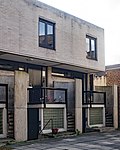Junction Road, London

Junction Road is a section of the A400 road in Upper Holloway, north London, running between Archway tube station (at the top of Holloway Road) and Tufnell Park tube station (where the A400 continues southwards as Fortess Road). The street has a number of restaurants, bars and pubs. Junction Road is home to Archway Tower, a building whose appearance is divisive and there is debate as to whether it should be demolished. However, the tower was remodelled in the 2010s with new cladding providing a more modern appearance. Junction Road railway station stood on the corner of Junction Road and Station Road until its closure in 1943. It was on what is now London Overground's Gospel Oak to Barking line, between Gospel Oak station and Upper Holloway station. The postal district is N19.
Excerpt from the Wikipedia article Junction Road, London (License: CC BY-SA 3.0, Authors, Images).Junction Road, London
Junction Road, London Upper Holloway (London Borough of Islington)
Geographical coordinates (GPS) Address Nearby Places Show on map
Geographical coordinates (GPS)
| Latitude | Longitude |
|---|---|
| N 51.55826 ° | E -0.13785 ° |
Address
Fulbrook Road
Junction Road
N19 5QG London, Upper Holloway (London Borough of Islington)
England, United Kingdom
Open on Google Maps









